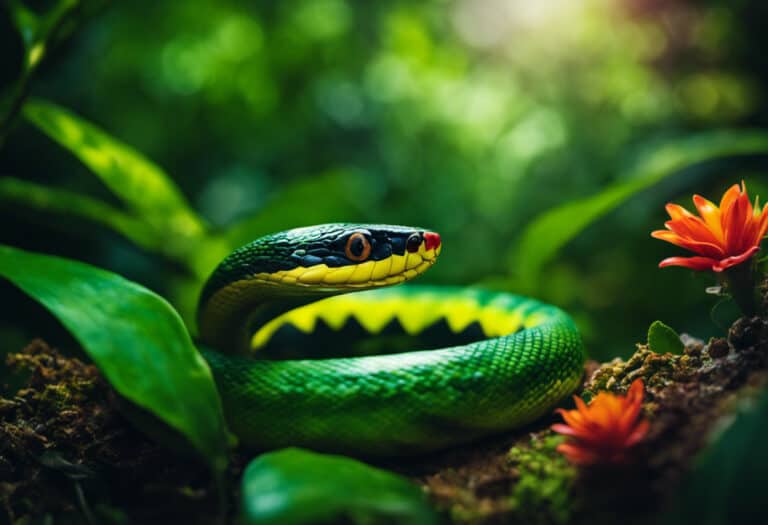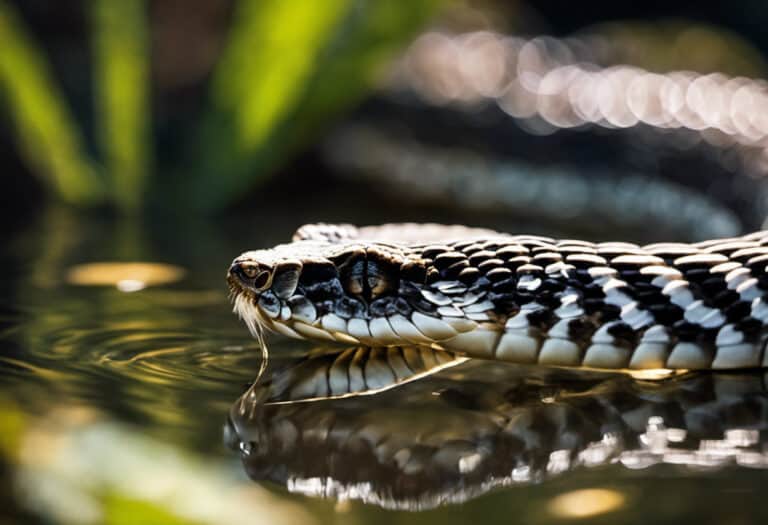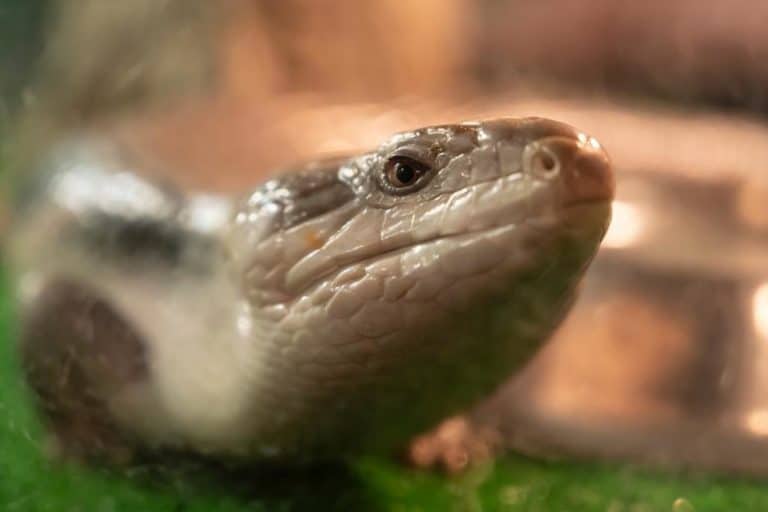Do Bull Snakes Like Water?
Do you ever wonder if bull snakes enjoy being in the water? Well, you’re about to find out! In this article, we’ll explore the fascinating world of bull snakes and their relationship with water.
Did you know that all snakes, including bull snakes, have the ability to swim? Whether it’s to escape threats or cool off on hot days, bull snakes are known to venture into ponds and bodies of water.
Join us as we delve into their behavior, habitat, and appearance to uncover the mysteries of their affinity for water.
Key Takeaways
- Bull snakes are capable of swimming.
- They may swim when they feel cornered or need to escape.
- Bull snakes can be found in ponds.
- Bull snakes have a small diamond-like pattern.
The Aquatic Abilities of Bull Snakes
Bull snakes, like other snakes, have the ability to swim when they need to escape or feel cornered.
Their swimming techniques are quite remarkable. When in water, bull snakes use lateral undulation, a movement where they push against the water with their body, creating a wave-like motion that propels them forward.
They also utilize their muscular bodies to navigate through the water with ease.
The impact of water on bull snakes’ behavior is significant. While they aren’t fully aquatic, they’re highly adaptable to water habitats.
Bull snakes can be found near water sources such as ponds and streams, where they may hunt for prey or seek refuge. Water provides them with opportunities for escape and survival, making it an important aspect of their natural environment.
Bull Snakes and Their Relationship With Water
Bull snakes have a unique relationship with water, as they’re capable swimmers. When feeling threatened or in need of escape, bull snakes may take to the water as a means of safety.
Their ability to navigate aquatic environments allows them to access new habitats and find refuge when necessary.
Swimming Habits of Bull Snakes
Snakes, including bull snakes, are capable of swimming when they feel cornered or need to escape. Their ability to navigate through water enables them to explore various habitats, including aquatic environments.
Here is a list that highlights the swimming abilities of bull snakes and their relationship with aquatic habitats:
-
Adaptation: Bull snakes have a streamlined body shape and muscular movements that allow them to propel through water efficiently. This adaptation enables them to navigate through ponds, rivers, and other bodies of water.
-
Hunting: While bull snakes primarily feed on small mammals and birds, their swimming abilities also enable them to hunt aquatic prey such as fish, frogs, and even small turtles. This versatility in their diet allows them to exploit resources in aquatic habitats.
-
Escape and Survival: In situations where bull snakes feel threatened or need to escape from predators, their swimming abilities provide an additional means of evasion. By taking to the water, they can quickly move to safety and find refuge in aquatic environments.
Understanding the swimming abilities of bull snakes and their relationship with aquatic habitats is crucial in appreciating their adaptability and freedom in the natural world.
Aquatic Habitats for Bull Snakes
When exploring aquatic habitats, you may notice bull snakes swimming gracefully through ponds and rivers. These snakes have adapted to their watery environments through various water-based adaptations.
They’re capable swimmers, using their muscular bodies to propel themselves through the water. Their scales are water-resistant, allowing them to move efficiently without becoming waterlogged.
Bull snakes also have the ability to hold their breath for extended periods of time, enabling them to explore underwater environments. Their aquatic behavior includes hunting for prey, such as fish and amphibians, and finding suitable places to mate and lay eggs.
These water-based adaptations make bull snakes highly adaptable and successful in their aquatic habitats, showcasing the freedom and resilience of these fascinating creatures.
Water as an Escape
As you explore aquatic habitats, you’ll notice that water serves as a means of escape for these adaptable creatures. Bull snakes, like many other snakes, are capable swimmers. They utilize specific swimming techniques to navigate through water effectively. Here are the benefits of water for bull snakes:
-
Escape: Water provides a quick and efficient escape route for bull snakes when they feel threatened or cornered. They can swiftly glide through the water, avoiding potential predators or dangerous situations.
-
Hunting: Bull snakes also benefit from water when it comes to hunting. They can ambush their prey near water sources, taking advantage of the increased activity of small mammals, birds, and reptiles that come to drink or bathe.
-
Thermoregulation: Water helps bull snakes regulate their body temperature. They can submerge themselves in cooler water to cool down during hot summer days or bask near the water’s edge to warm up in colder weather.
Water plays a crucial role in the lives of bull snakes, providing them with a means of escape, opportunities for successful hunting, and a way to regulate their body temperature. Embrace your freedom as you explore these fascinating aquatic habitats and witness the adaptability of bull snakes in their swimming techniques.
Exploring Bull Snakes’ Attraction to Water
Bull snakes, like many other snake species, are attracted to water for various reasons. They may seek out water sources for hydration, to regulate their body temperature, or even for hunting opportunities.
Their ability to swim allows them to navigate through ponds or other bodies of water, making them versatile and adaptable in their natural habitat.
Aquatic Adaptations in Bull Snakes
You may be interested to know that bull snakes, like many other snakes, have adaptations that allow them to swim when necessary. Here are three aquatic adaptations and swimming habits of bull snakes:
-
Streamlined Body: Bull snakes have a slender and elongated body shape, which helps reduce drag and allows for efficient movement through water. Their muscles are also well-developed, enabling them to generate the necessary propulsion for swimming.
-
Scaled Belly: The ventral scales on a bull snake’s belly are smooth and slightly keeled, providing traction against the water’s surface. This feature helps them maintain stability and control while swimming.
-
Ability to Hold Breath: Bull snakes have the ability to hold their breath for extended periods underwater. This allows them to navigate through bodies of water, such as ponds or streams, in search of prey or to find shelter.
These adaptations enable bull snakes to be versatile and thrive in different environments, including aquatic habitats. So, if you ever come across a bull snake swimming, know that it’s perfectly natural for them to do so.
Reasons for Bull Snakes Swimming?
If you encounter a bull snake swimming, it’s likely because they feel threatened or need to escape from a potential danger. Swimming is a common behavior among bull snakes, and it serves several important purposes for them.
Firstly, swimming allows bull snakes to quickly move away from predators or other threats that they may encounter in their environment. Secondly, it provides them with a means of accessing new habitats and resources, such as food or shelter.
Additionally, swimming helps to regulate their body temperature, as water can provide a cooling effect on hot days. Overall, swimming is an adaptive behavior for bull snakes, allowing them to navigate their surroundings and ensure their survival in the wild.
Water as a Natural Habitat for Bull Snakes
Water serves as a natural habitat for bull snakes, as they can be found near water sources such as ponds and are even capable of swimming. Understanding the importance of water for bull snake survival is crucial. Here are three key points about bull snakes and their aquatic behavior:
-
Adaptation to water: Bull snakes have developed the ability to swim, allowing them to explore their surroundings and escape potential threats. Their streamlined bodies and muscular movements enable them to navigate through water with ease.
-
Hunting opportunities: Water sources attract prey species like small mammals, birds, and amphibians. Bull snakes take advantage of these hunting opportunities by lurking near water, waiting for their next meal to appear.
-
Thermoregulation: Water bodies provide bull snakes with the opportunity to regulate their body temperature. They can bask in the sun on rocks or logs near the water, warming themselves up, or cool off by submerging themselves in the water during hot periods.
Factors Influencing Bull Snakes’ Interaction With Water
When near water, bull snakes are influenced by factors such as temperature, prey availability, and the need for thermoregulation. Bull snakes are capable of swimming, although it isn’t their preferred method of movement. They may swim when they feel cornered or need to escape.
Bull snakes and water ecology have a complex relationship. They can be found in ponds, where they may encounter other aquatic species. However, their main habitat consists of grasslands, deserts, and open forests.
Bull snakes are carnivorous reptiles and primarily feed on small mammals, such as mice and rats. While they occasionally consume amphibians and insects, their diet mainly consists of terrestrial prey.
Bull Snakes’ Swimming Behaviors Unveiled
You may be surprised to learn that bull snakes are actually quite capable swimmers. These fascinating reptiles have adapted to the water and are known to navigate through ponds and other bodies of water with ease. Here are three key facts about bull snakes and their swimming abilities:
-
Natural swimmers: Bull snakes possess the physical traits necessary for swimming, including a streamlined body and muscular scales that aid in propulsion. They can propel themselves through the water using lateral undulation, similar to the way they move on land.
-
Aquatic behavior: While bull snakes are primarily terrestrial, they aren’t averse to water. They may enter water sources to escape predators, search for food, or regulate their body temperature. They can submerge themselves and remain underwater for extended periods of time.
-
Water habitats: Bull snakes can be found in a variety of habitats, including grasslands, deserts, and open forests. They’re also known to inhabit areas near water sources such as ponds and rivers. Their ability to swim allows them to explore and utilize these environments effectively.
Investigating the relationship between bull snakes and water is crucial for understanding their behavior and ecological role. By studying their swimming abilities, scientists can gain insight into the adaptability and versatility of these remarkable creatures.
Bull Snakes and Their Adaptations for Water Environments
Bull snakes, like many other snake species, have adaptations that allow them to survive in water environments.
While they aren’t considered aquatic snakes, they can swim when necessary. Bull snakes typically prefer water sources such as ponds, lakes, and rivers, where they can find prey and cool off during hot weather.
Water has a significant impact on their behavior, as it provides them with opportunities for hunting and escaping predators. When in water, bull snakes may exhibit different behaviors compared to their terrestrial counterparts.
They may move more fluidly and utilize their strong muscles to navigate through the water. Additionally, water can provide them with camouflage, making it easier for them to hide from potential threats.
Overall, bull snakes have adapted to utilize water as a valuable resource in their environment.
The Role of Water in Bull Snakes’ Survival
Water environments play a crucial role in the survival of bull snakes, as they provide opportunities for hunting, cooling off, and hiding from potential threats.
-
Hunting: Bull snakes are skilled predators and often hunt near water sources, where they can find a variety of prey, such as small mammals, birds, and even amphibians. The presence of water attracts their prey, increasing their chances of a successful hunt.
-
Cooling off: Like all reptiles, bull snakes are ectothermic, meaning they rely on external sources of heat to regulate their body temperature. Water environments offer a cool refuge for bull snakes during hot weather, allowing them to avoid overheating.
-
Hiding from threats: Water environments provide bull snakes with ample hiding spots, such as vegetation, burrows, and submerged rocks. These hiding places offer protection from potential threats, such as predators or human disturbances.
Overall, water environments play a crucial role in shaping the behavior and survival of bull snakes, providing them with essential resources and refuge.
Unraveling the Mysteries of Bull Snakes’ Affinity for Water
Unraveling the mysteries of why bull snakes are drawn to water environments can provide valuable insights into their behavior and survival strategies.
Bull snakes, like many other snake species, are capable swimmers. They utilize specific swimming techniques to navigate through water, such as undulating their bodies and using their muscles to propel themselves forward.
This affinity for water is likely influenced by their preference for aquatic prey. Bull snakes are known to feed on a variety of aquatic creatures, including fish, amphibians, and even small turtles.
Their ability to swim allows them to access these food sources more easily, enhancing their chances of survival.
Understanding the swimming techniques and preference for aquatic prey in bull snakes can provide a greater understanding of their ecological role and their ability to adapt to different environments.
Frequently Asked Questions
Can Bull Snakes Swim?
Yes, bull snakes can swim. They are found in a variety of habitats, including grasslands, deserts, and open forests, and they are known to tolerate a wide range of temperatures. In terms of diet, bull snakes are carnivorous and feed on small mammals, birds, eggs, and other reptiles.
What Are the Adaptations of Bull Snakes for Water Environments?
Bull snakes have adapted to various habitats, including water environments. They can tolerate a wide range of temperatures and are often seen near water sources. Their diet consists of small mammals, birds, reptiles, and occasionally amphibians and insects.
Do Bull Snakes Prefer to Live Near Water Sources?
Bull snakes, like other snakes, are capable of swimming. While they prefer grasslands and open forests, they can also be found near water sources. Their diet consists of small mammals, birds, eggs, and other reptiles.
How Do Bull Snakes Behave When They Encounter Water?
When encountering water, bull snakes have the ability to swim but they don’t necessarily prefer it. They may swim when feeling cornered or needing to escape. So, while they can go in water, it’s not their preferred habitat.
Is Water Essential for the Survival of Bull Snakes?
Water is essential for the survival of bull snakes. Hydration is important for their overall well-being, including reproductive behavior. Adequate access to water ensures their health and enables them to thrive in their natural habitat.
Conclusion
In conclusion, the captivating world of bull snakes and their affinity for water has been unraveled. These magnificent creatures not only possess the ability to swim but also display various behaviors and adaptations that make them well-suited for water environments.
Their attraction to water may stem from a need to escape threats or seek respite from scorching temperatures. By delving into their behavior, habitat, and appearance, we’ve gained a better understanding of the fascinating relationship between bull snakes and water.






